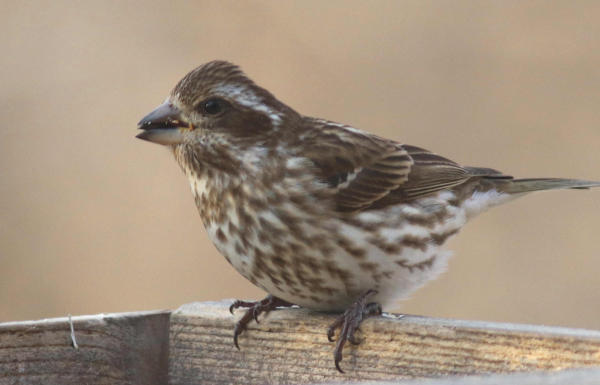
A female Purple Finch, photographed at a nature center feeder.
|
During birding trips in your area and in towns you pass through along the way, keep an eye out for bird feeders and water features in people’s yards. First, to see what birds are visiting a given feeding station, and second to see what kind of feeders, foods and other attractions are being offered, and utilized. If you drive by from time to time, and during different seasons, you get a good appreciation for what other birders are doing, what birds they are attracting as a result, and you will likely get a few tips along the way.
You may well get inspired by some birders’ feeding stations and landscaping. What works, what doesn’t? What kinds of feeders are others using, how are they mounted, what foods are offered, and what birds are coming to the site? How did they make that natural-looking water feature?
Sometimes, though, you may find yourself a bit disappointed by empty feeders and the lack of cleanliness of feeders, but in a given community there is bound to be some good, a little bad and lots of in-between.
You can expand this practice of checking out feeding stations to include refuge headquarters and nature centers where personnel keep active feeding stations. One of the best of these that I’ve appreciated is at Laguna Atascosa National Wildlife Refuge, north of Brownsville, Texas. There, refuge personnel and volunteers have a couple feeding stations around the headquarters, including one particularly large one where you may see such impressive species as Green Jays, Altamira Orioles, Plain Chachalacas, Golden-fronted Woodpeckers, White-tipped Doves, and more – feeding, drinking, bathing, interacting.
While doing a feeding station “drive-by,” be careful not to be too obvious, and never train binoculars on people’s homes, or even their feeding stations, to preserve their privacy should someone become overly concerned with your quick look at their feeders.
Periodically, birders find rare birds at a feeder – sometimes by “accident,” and sometimes because a homeowner alerts a birder they know about an unusual bird that begins visiting their feeding station that they haven’t seen before. In the latter case, the home-owners almost always give permission to birders who wish to see a rare bird at their feeders.
I certainly appreciate it when neighbors, community members or rare bird chasers take an interest in my feeding station. I have had a couple “rare” birds in my yard: A Red-bellied Woodpecker frequented my suet feeder one winter, and White-winged Crossbills were a thrill another winter. It was fun to share these species rarely encountered in my area.
You never know what birds you may find as you travel. I recently began keeping a bag of black-oil sunflower seeds in my vehicle, just in case I have an opportunity to try to attract birds here and there as I stop along the way – I’ll let you know if that plan works out. In the meantime, enjoy your winter feeding station and all the birds it attracts!